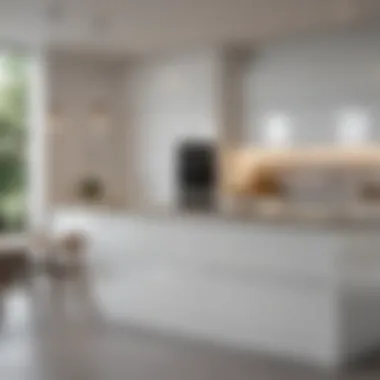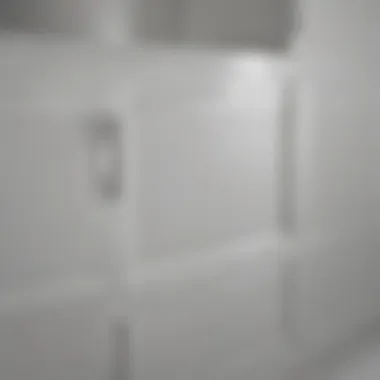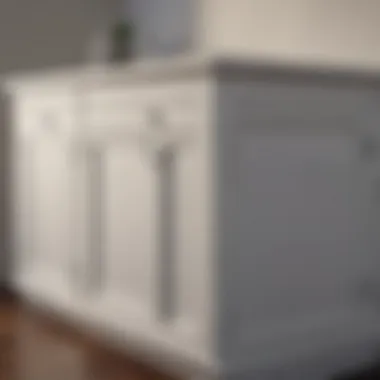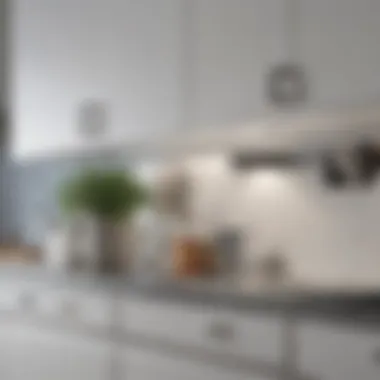Comprehensive Cost Analysis of Painting Cabinets White


Intro
Painting cabinets white has become a favored choice among homeowners and renters alike. This transformation not only updates the aesthetic of a space but also invokes a sense of cleanliness and simplicity. However, before embarking on this project, it is crucial to understand the financial commitments involved.
This article presents a meticulous cost analysis, outlining various aspects that affect pricing. By investigating expenses for materials, labor, and the scope of the project, individuals can better prepare for a cabinet painting endeavor. The information collected serves as a guideline for making judicious financial choices.
Key Insights and Trends
Current Trends in Interior Design
In recent years, minimalism has steered many design preferences, with white cabinets epitomizing this approach. Their versatility allows seamless integration with various styles, from contemporary to traditional.
Moreover, the inclination towards sustainable and eco-friendly materials has emerged. Homeowners often select low-VOC (volatile organic compounds) paints for their cabinets, promoting better indoor air quality while maintaining a fresh look.
The Financial Aspect of Painting Cabinets
Understanding the average costs associated with painting cabinets helps homeowners make informed decisions. The price range can vary, yet knowing the average financial outlay for both DIY and professional services is vital. Factors such as the quality of paint, the number of cabinets, and potential alterations in the design impact overall pricing.
Expected costs can range from roughly $200 to $2,000 or more, depending on various influencing elements.
Practical Tips and How-To Guides
Step-by-Step Guide for Painting Cabinets
- Preparation: Begin by removing cabinet doors and hardware. Clean surfaces thoroughly to ensure proper adhesion of paint.
- Sanding: Lightly sand the surface to create texture for paint adhesion. This step helps in achieving a smooth final finish.
- Priming: Apply a high-quality primer to seal the surface, especially important for raw wood or previously stained cabinets.
- Painting: Use a sprayer for a smooth finish or a paintbrush/roller for more control. Ensure even coat application for a professional look.
- Reassembly: Allow the paint to cure before reattaching the doors and hardware, which enhances durability.
Cost-Saving Strategies
- DIY Approach: By painting cabinets yourself, significant labor costs can be eliminated.
- Bulk Material Purchase: Buying paint and supplies in larger quantities may reduce overall material costs.
- Seasonal Sales: Timing your purchases during sales can lead to substantial savings.
Painting cabinets white can be a budget-friendly choice if approached with careful planning and consideration of costs.
Understanding Cabinet Painting
Cabinet painting is a significant aspect in interior design and home improvement. It not only enhances the aesthetic appeal of a kitchen or bathroom but also offers an economical solution to improve an outdated space. The importance of understanding the nuances of cabinet painting cannot be overstated, particularly when considering a color change such as white.
Definition and Importance
Cabinet painting refers to the process of applying paint to cabinetry surfaces. This may involve removing old finishes, preparing surfaces, and applying one or more coats of color. The importance of properly understanding this process is critical. Achieving a professional-looking finish requires knowledge of the right materials, proper techniques, and preparation methods. Furthermore, understanding cabinet painting aids in setting realistic expectations for the time and cost involved. Homeowners must appreciate that poor execution can result in a finish that deteriorates quickly, leading to additional expenses.
The Benefits of White Cabinets
White cabinets offer several benefits in both functionality and aesthetics. First, they provide a clean and timeless look that can easily complement various design styles, from modern to traditional. White also reflects light, making spaces feel larger and more open. Furthermore, white cabinetry can increase the perceived value of a home, making it more appealing to potential buyers.
In addition, white cabinets are versatile. They serve as a blank canvas, allowing for easy accessory changes, whether through decorative items or contrasting colors in countertops and backsplashes. This flexibility in design can significantly enhance the overall ambiance of a kitchen.
Overall, understanding cabinet painting, particularly the choice of color, like white, can maximize investment in home improvement projects. It is a decision that can transform a space while adding long-term value.
Factors Influencing Cost
Understanding the elements that influence the cost of painting cabinets white is crucial for achieving a budget-conscious outcome. A variety of factors play significant roles in determining the overall financial implications of such a project. You should consider how these factors can change pricing significantly, which allows for informed decision making.
Type of Paint
The type of paint used is one of the most critical factors in the cost analysis of painting cabinets. There are various types of paint options available, including acrylic, latex, and oil-based paints. Each of these comes with different qualities and price points.
- Acrylic Paint: Generally more affordable and quick drying but may not be as durable as other types.
- Oil-Based Paint: Often provides a smoother finish and durability, but it has higher costs and a longer drying time.
Selecting the right paint can affect both the immediate costs and long-term durability, impacting wear and tear over time. Homeowners must weigh these factors carefully to align choice with their budget.


Quantity of Cabinets
The number of cabinets you intend to paint directly affects the overall cost. A larger quantity implies a greater amount of paint, additional materials, and labor — hence, escalating totals. Here are some points to consider:
- Single Cabinet vs. Full Kitchen: Painting a single cabinet may appear inexpensive; however, a full kitchen often demands significant investment in materials and labor.
- Size Matters: Larger cabinets may require more paint and preparation, increasing the overall material costs.
Calculating the precise number can provide a clearer picture of the projects monetary demands.
Preparation Work Required
Preparation work is often overlooked but is key to successful cabinet painting. This phase includes cleaning, sanding, and sometimes applying a primer. Each task bears its expense and time commitment:
- Cleaning: Removing grease and grime to create a pristine surface.
- Sanding: This helps in creating a smooth finish but may require purchasing additional tools.
- Priming: A necessary step for certain paint types, enabling better adherence.
Neglecting preparation might lead to poor outcomes, necessitating costly redo work.
Labor Costs
Labor costs represent a significant portion of total expenses. Whether you choose to hire professionals or attempt DIY, understanding labor pricing is essential.
- Hiring Professionals: Costs can vary by region and expertise. Be prepared for pricing differences based on local market rates.
- DIY Projects: Though labor costs may decrease, factor in time and effort, which could be invaluable.
Evaluating these costs allows you to plan your project effectively, ensuring you remain within budget.
Location and Market Variation
The geographical location and fluctuations in the local market can influence overall costs substantially. Areas with a higher cost of living typically reflect higher prices for both materials and labor. Here are some elements that can lend insight:
- Urban vs. Rural Living: Major cities may have higher pricing dynamics due to demand. Conversely, rural areas may offer lower costs.
- Seasonal Trends: During peak seasons, prices may rise as demand increases. Awareness of local fluctuations can ensure optimal timing for painting projects.
By understanding these factors, you can better anticipate total costs and save where possible.
Estimating the Cost
Estimating the cost of painting cabinets white is a crucial aspect of the overall project planning process. Understanding these costs helps homeowners make educated decisions about their investment and budgeting. Without this understanding, one can quickly become overwhelmed by the various expenses. The significance of correctly estimating costs lies in ensuring that the project does not spiral out of control financially. In doing so, homeowners can prioritize their spending and identify areas where they can save or allocate funds effectively.
Initial Material Costs
The first step in estimating the costs for painting cabinets involves analyzing the initial material costs. This includes the paint itself, along with any tools needed for the job. The quality of paint chosen directly affects the total expenditure. High-quality paints, such as Benjamin Moore or Sherwin-Williams, can range from $40 to $80 per gallon. Meanwhile, cheaper options from brands like Behr or Valspar may cost $25 to $35 per gallon. The choice of primer should also be considered, as a good primer may vary from $15 to $35 per gallon.
When estimating for cabinets, it is important to calculate the total area to be painted. Most kitchens will require several gallons of paint and primer. Homeowners need to consider additional items like brushes, rollers, drop cloths, and painter's tape. Thus, initial material costs can significantly influence the overall budget, making this a critical component to assess at the outset.
Average Labor Rates
Labor costs significantly contribute to the total expenses when painting cabinets. Rates vary widely based on geographic location, complexity of the job, and whether a homeowner is hiring a professional or relying on DIY efforts. On average, hiring a professional painter can cost anywhere from $20 to $50 per hour. For an entire cabinet refinishing project, costs may range from $300 to $1,000, depending on the number of cabinets and the nature of the finishes required.
If a homeowner chooses to go the DIY route, while it may save money on labor, this choice may come with hidden costs. Time is a critical factor, as it may take several days for someone inexperienced to complete the project properly. Mistakes can occur, leading to the need for professional intervention later, which adds to the overall cost. Thus, carefully weighing labor options is vital in estimating the cost of painting cabinets.
Total Project Cost Range
Estimating the total project cost is an essential part of the planning process. Typically, the complete project cost can range anywhere from $500 to $3,000, depending on the factors discussed earlier. This total encompasses material costs, labor fees, and any additional expenses related to preparation or special finishes.
For instance, a straightforward DIY project for a small kitchen may cost about $500 if lower-quality materials and no professional help are employed. On the other hand, opting for high-end materials and hiring skilled labor may result in a total expenditure of $2,500 to $3,000 for larger spaces or more intricate designs.
Understanding this broad range gives homeowners a starting point. They can adjust expenses to their budget while preparing for potential unexpected costs. Planning ahead is essential for achieving an effective and satisfying cabinet painting project.


Potential Additional Expenses
Understanding potential additional expenses when painting cabinets white is crucial for an accurate cost analysis. Homeowners often overlook these factors, which can affect the overall budget and timeline for the project. Various hidden costs can arise during the process, and being prepared for these can help in making informed decisions.
Surface Preparation and Repair
Surface preparation is an essential step in achieving a smooth finish. It involves cleaning, sanding, and patching any imperfections on the cabinets. This work is vital for ensuring proper adhesion of the paint. Neglecting surface preparation can lead to inadequate results, ultimately costing more in the long run to redo the work. For instance, filling in cracks and holes may require specific materials like wood filler, which adds to the initial expense. Furthermore, the time spent on these preparatory tasks could increase overall labor costs.
Special Finishes or Techniques
If homeowners desire a unique touch, special finishes or techniques may be worth considering. Options include glazing, distressing, or applying a textured finish. These methods can significantly enhance aesthetic appeal but often come with added costs. Specialized materials, tools, and skilled labor are typically needed, driving up the expenses. Depending on the complexity, these techniques might also extend the project timeline, resulting in further labor charges. Therefore, it's important to evaluate whether the added expense aligns with the homeowner's vision and budget for the cabinetry.
Disposal and Cleanup Costs
Post-project cleanup and disposal of leftover materials is another often overlooked component of total costs. Once the painting is completed, it is necessary to dispose of paint cans, brushes, and any other debris. Some local waste management services may have specific disposal fees, particularly for hazardous materials like paint. Furthermore, the cost of cleaning tools and ensuring the workspace is free of paint residue can accumulate. These combined expenses can influence the final tally and should be anticipated beforehand.
Key Consideration: Always account for potential additional expenses when budgeting for painting cabinets. It's better to overestimate costs in this area than to be surprised by unexpected charges.
DIY vs. Professional Service
When considering the cost of painting cabinets white, one pivotal decision revolves around whether to tackle the project as a do-it-yourself (DIY) venture or to hire a professional service. This decision carries significant implications for both the budget and the quality of the final outcome. While DIY can appear enticing due to potential cost savings, professional services often provide benefits that may justify their higher upfront expense. Understanding the specific elements involved will guide homeowners in making an informed decision.
Pros and Cons of DIY Painting
Opting for a DIY approach comes with distinct advantages:
- Cost Savings: The most apparent benefit is the reduction in labor costs. Without hiring a professional, the budget primarily focuses on materials.
- Personal Control: DIY allows complete control over every aspect of the project, from color choices to technique.
- Skill Development: Engaging in DIY projects can enhance painting skills and home improvement knowledge.
However, there are also notable drawbacks:
- Time-Consuming: The time required for preparation, painting, and drying can extend the project significantly.
- Varied Results: Without professional experience, results may vary. Risks of uneven application, drips, or missed spots are higher.
- Potential for Cost Overruns: If mistakes are made, additional expenditures for touching up or correcting issues may occur.
Homeowners need to weigh these factors against their capabilities and the time they are willing to commit.
When to Hire a Professional
While DIY projects can sometimes be rewarding, certain circumstances suggest hiring a professional is the better choice:
- Complex Cabinet Designs: Intricately designed cabinets may require specialized techniques to achieve a flawless finish.
- Time Constraints: If a project must be completed within a tight timeframe, professionals can often work more efficiently.
- Quality Assurance: For those seeking guaranteed high-quality results, professionals bring expertise, experience, and often better tools.
- Warranty and Support: Many professional services offer warranties on their work, providing peace of mind in case of future issues.
Ultimately, the choice between DIY and professional painting hinges on personal skill levels, available time, and the desired outcome for the cabinets.
"Understanding the nuances of either approach will save you both time and money in the long run."
Each option has its merits, and weighing them carefully is key to a successful cabinet makeover.
Cost-Saving Strategies
Understanding cost-saving strategies when painting cabinets white can significantly affect the overall budget for your project. Implementing these strategies not only reduces expenses but also maximizes the value you receive for your investment. Each component of this process—from selecting materials to timing your project—can lead to notable savings. This section will explore three essential aspects of cost-saving: choosing the right paint, timing your project wisely, and leveraging discounts and sales.
Selecting the Right Paint
The choice of paint is critical when planning to paint cabinets. Not all paints are created equal; some offer better durability and coverage than others. Opting for a high-quality paint may seem costlier initially; however, it often provides greater longevity and a better finish. Here are some points to consider while selecting your paint:


- Type of Paint: Water-based paints tend to dry faster and are easier to clean up, making them suitable for many projects. However, oil-based paints often provide a smoother finish and more durability.
- Finish: Consider whether you prefer matte, satin, or semi-gloss. Semi-gloss generally withstands wear and tear better, which can save costs associated with repainting in the future.
- Quantity Required: Calculate the exact amount you need based on cabinet size. Buying in bulk may also reduce per-unit costs.
Timing Your Project
Timing can directly influence the overall cost and efficiency of your cabinet painting project. Begin by considering when to start your project:
- Off-Peak Seasons: Painting during cooler weather can lead to better drying conditions and may help avoid rush pricing from contractors.
- Schedule Wisely: Block out time to focus solely on the task. Rushing can lead to mistakes that cost more in touch-ups later.
- Plan Around Sales: Keep an eye on seasonal sales events, where paint stores often reduce prices. This can significantly lower material costs.
Leveraging Sales and Discounts
Finding ways to save on materials and services can dramatically reduce the overall expense of painting cabinets. Here are strategies to consider:
- Couponing or Membership Discounts: Many paint retailers offer discounts for members or through loyalty programs.
- Clearance Products: Look for clearance paints or supplies that might have slight imperfections but are still perfectly usable.
- Online Discounts: Check online retailers. Websites may offer exclusive deals or reduced shipping costs that local stores might not provide.
Implementing cost-saving strategies is essential for homeowners who want to maximize their investment when transforming their cabinets into something fresh and appealing.
By being informed and strategic about paint selection, project timing, and utilizing discounts, you can ensure that your painting project remains within budget while achieving the desired aesthetic.
The Long-Term Value of Painted Cabinets
When considering home renovations, the long-term value of painted cabinets is often overlooked. However, this factor plays a crucial role in determining the overall return on investment. Homeowners are increasingly realizing that updating cabinet styles and finishes can significantly enhance the aesthetic and functional aspects of a kitchen or bathroom.
Enhancing Home Value
The immediate visual appeal of white cabinets can dramatically uplift the atmosphere of a space. Buyers often favor homes with modern finishes, making such updates attractive during resale. A fresh coat of white paint can create a sense of cleanliness and spaciousness. This is particularly advantageous in popular real estate markets where competition is fierce.
According to various studies, homes featuring renovated kitchens can see a return on investment upwards of 70%. In other words, spending on painting cabinets white becomes an investment rather than just an expense. Increased home value isn’t solely from the cabinet transformation; it also stems from the overall design and flow of the home created by visually appealing cabinetry.
For instance, complementing white cabinets with appropriate countertops or backsplash options can create a cohesive look that resonates with potential buyers. Thus, not only the act of painting but also the careful selection of complementary features plays into enhancing home value.
Maintenance and Durability Considerations
Durability and maintenance are critical components when thinking about the long-term viability of painted cabinets. Quality paint and proper application methods can prolong the lifespan of cabinetry while ensuring that it remains aesthetically appealing. Most homeowners desire finishes that are easy to clean and resilient against daily wear and tear.
Selecting high-quality paints formulated for cabinetry is essential. Products from brands like Benjamin Moore or Sherwin-Williams offer superior durability compared to regular wall paint. These paints can resist chipping and scratching, keeping cabinets looking new for many years.
Regular maintenance also plays a role. Simple cleaning routines can prevent the accumulation of dust and grease. Ensuring cabinets are well-sealed adds a layer of protection, making them last longer.
"Investing in quality finishes not only enhances appearance but also solidifies durability."
Beyond paint quality, environmental considerations should not be ignored. Bio-based or low-VOC (volatile organic compounds) paints can be a better choice for those concerned with indoor air quality. These products provide benefits without detrimental effects, ensuring a healthy living environment.
In summary, investing in painting cabinets white offers significant long-term value, enhancing not only the aesthetic appeal but also the functionality of home spaces. While the upfront cost may seem substantial, the combined effects on resale value and reduced maintenance will often justify the investment.
Final Thoughts on Painting Cabinets White
Painting cabinets white can be both a financially sensible choice and a design decision that enhances any interior space. It reflects light, making spaces feel bigger, and complements a variety of decor styles. The cost analysis of this project helps readers understand both the direct and indirect expenses involved. This section serves to tie the themes of the article together, emphasizing the various considerations that impact the painting process and overall financial implications.
Making an Informed Decision
Making an informed decision about painting cabinets white requires careful consideration of several factors. Homeowners should weigh the initial costs against potential long-term benefits. Understanding the materials needed, labor costs, and any additional expenses can lead to more effective budgeting. It is essential to research and choose high-quality paint, as this not only affects the final appearance but also the longevity of the finish. Being aware of market prices and seeking guidance from professionals can also aid in making a sound choice.
Furthermore, knowing the pros and cons can streamline the decision-making. For example, DIY efforts may result in cost savings but can take more time and may not yield a professional finish. Alternatively, hiring a professional guarantees expertise, though this comes at a higher cost.
Future Trends in Cabinet Painting
In the rapidly shifting world of home decor, several trends are emerging in cabinet painting. The minimalist aesthetic continues to gain popularity, making white cabinets a timeless choice. There is also a rising interest in sustainability, leading many homeowners to opt for eco-friendly paints. These options not only reduce environmental impact but also enhance air quality indoors.
Another trend is the use of mixed finishes in kitchen spaces. Combining white cabinets with darker hues or natural wood accents provides depth and visual interest. Homeowners might also explore innovative painting techniques, such as textured finishes or unique patterns, which can transform conventional spaces into modern designs.
As trends shift, maintaining versatility in design through white cabinets will likely remain appealing. Indeed, they serve as one of the most adaptable fixtures in home styling for years to come. Embracing these changes while staying true to one’s personal taste is crucial for making decisions that enhance both style and value.



